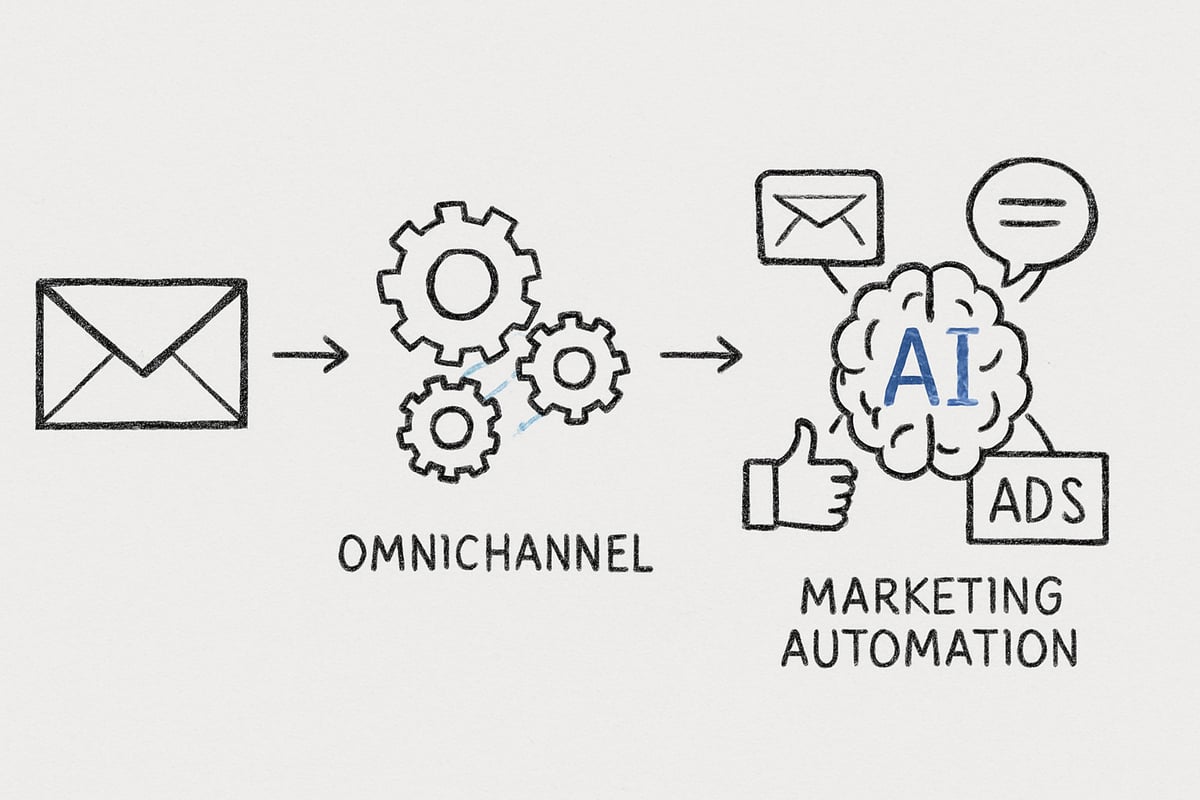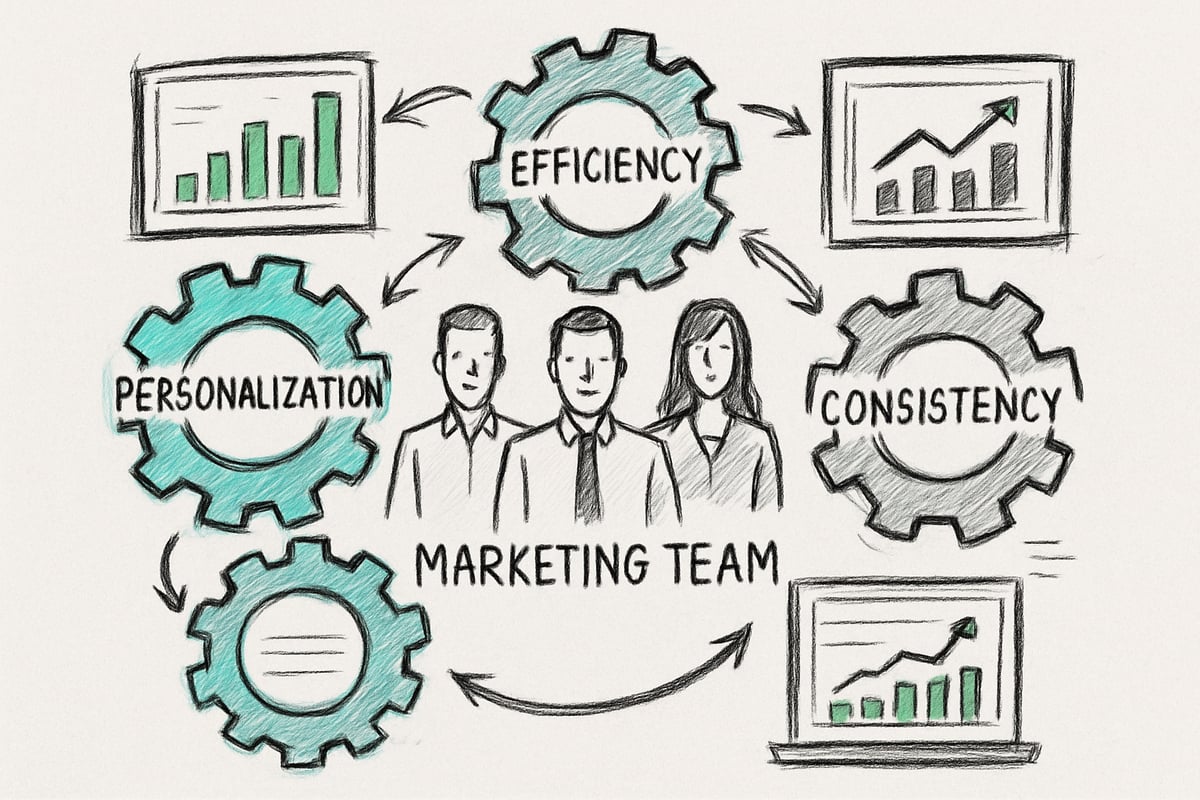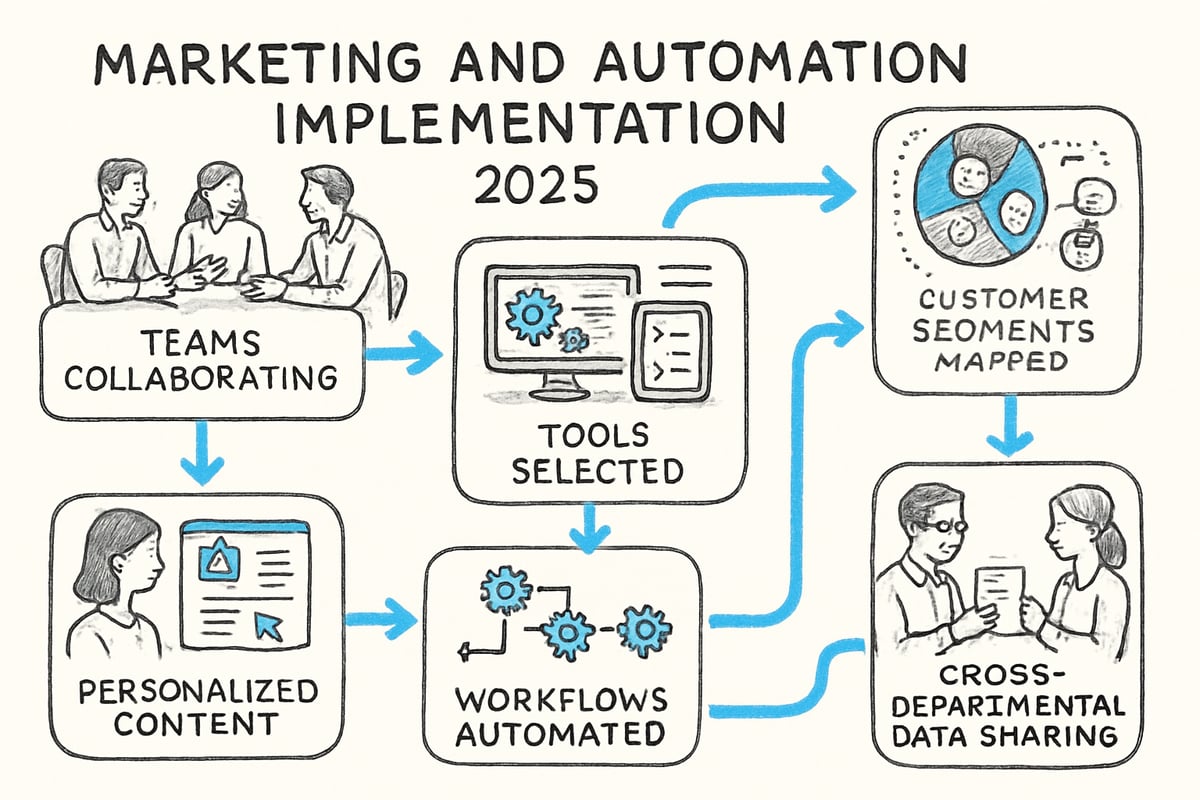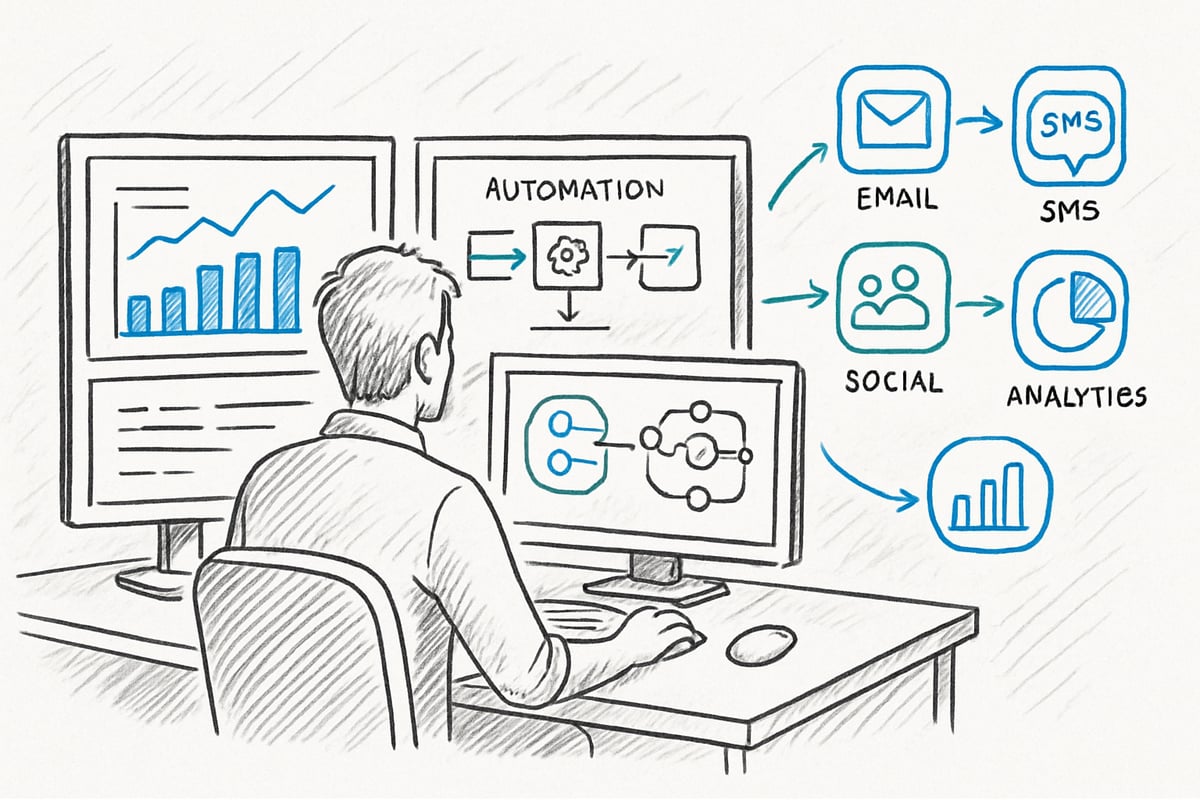The digital marketing world is accelerating, and manual methods can no longer keep up with today’s demands. Businesses that want to stand out in 2025 must embrace marketing and automation to streamline operations and drive results.
This guide reveals proven strategies and emerging trends to help you master marketing and automation for measurable success. You’ll discover the fundamentals, understand the benefits, and learn step-by-step how to implement automation for your business.
Explore real-world examples, discover industry-leading tools, and see how top brands are using marketing and automation to personalize customer experiences and maximize ROI. Ready to future-proof your growth? Start your journey now.
Understanding Marketing Automation in 2025
Marketing and automation continue to reshape how brands connect with customers. In 2025, these systems are more sophisticated than ever, blending artificial intelligence, data analytics, and real-time engagement. Businesses that adapt to these advancements can streamline operations, enhance personalization, and outperform competitors.

The Evolution of Marketing Automation
The journey of marketing and automation began with basic email scheduling tools. Over time, these evolved into platforms capable of managing entire customer journeys across multiple channels. By 2025, automation platforms leverage AI for predictive analytics, enabling hyper-personalized content delivery.
According to recent Marketing Automation Adoption Rates, 78% of companies already use automation tools for their marketing operations. This shift reflects a growing recognition that data-driven decision-making and scalable processes are essential for success.
Today, marketing and automation platforms unify data, manage campaigns, and trigger responses in real time. Their evolution is driven by the demand for relevant, timely communication in a crowded digital landscape.
Core Components and Capabilities
Modern marketing and automation tools cover a range of functions. They automate emails, SMS messages, social media posts, and even digital advertising. Integration with CRM systems and analytics platforms ensures that every customer interaction is tracked and optimized.
A key capability is automated lead scoring, where prospects are ranked based on engagement and purchase intent. Segmentation tools allow marketers to tailor content for different audiences. For example, chatbots can instantly route product inquiries from a website to the appropriate sales team, increasing response speed and customer satisfaction.
These components work together to build a seamless, data-driven workflow. Marketing and automation platforms are now essential for delivering the right message, to the right person, at the right time.
Key Differences: Email Marketing vs. Full Marketing Automation
Email marketing is just one piece of the marketing and automation puzzle. While email tools focus on sending messages and tracking responses, full automation platforms manage entire campaigns across multiple channels. This distinction is critical for brands aiming for consistency and scale.
| Feature | Email Marketing | Full Marketing Automation |
|---|---|---|
| Channel Coverage | Emails only | Email, SMS, social, ads |
| Personalization | Basic | Advanced, AI-driven |
| Integration | Limited | CRM, analytics, CMS, more |
| Lead Management | Minimal | Scoring, nurturing, segmentation |
Marketing and automation strategies ensure that brand messaging remains consistent, regardless of where or how customers interact. This cross-channel approach reinforces trust and drives stronger results.
Why Marketing Automation is Essential for 2025
Manual marketing processes create bottlenecks and increase the risk of errors, especially in fast-moving digital environments. Marketing and automation allow businesses to operate at scale, delivering campaigns faster and with greater accuracy.
Companies using automation report productivity gains of over 20%. Automated workflows replace repetitive tasks, freeing up teams to focus on strategy and creativity. Marketing and automation also enable precise targeting, ensuring that each message is relevant to the recipient.
In 2025, the ability to act quickly and accurately is a competitive advantage. Marketing and automation are no longer optional—they are necessary for sustainable growth.
Common Use Cases Across Industries
Marketing and automation platforms are adaptable across sectors:
- B2B: Manage complex customer journeys, automate lead nurturing, and accelerate pipeline movement.
- B2C: Deliver personalized offers, recover abandoned carts, and run loyalty programs.
- Example: When a customer abandons a cart, automation triggers a retargeting ad and a personalized follow-up email, increasing the chance of conversion.
By leveraging marketing and automation, companies create tailored experiences that drive engagement and revenue. Whether targeting businesses or consumers, automation ensures every interaction is timely and relevant.
The Business Impact: Benefits and ROI of Marketing Automation
Adopting marketing and automation in 2025 is not just an upgrade—it is a strategic necessity. As digital channels multiply and customer expectations soar, businesses need tools that can deliver consistent, scalable results. Let us explore how marketing and automation directly impact business success, from streamlining workflows to maximizing ROI.

Streamlining Repetitive Tasks and Workflows
One of the most immediate benefits of marketing and automation is the elimination of time-consuming manual tasks. Automating actions like email sends, social media posting, lead follow-ups, and reporting allows teams to focus on strategy instead of repetitive work.
- Automated scheduling tools optimize content delivery times.
- Reporting dashboards provide instant insights without manual compilation.
- Workflows trigger follow-up emails or SMS based on user actions.
By reducing manual errors and freeing up valuable resources, marketing and automation enable teams to operate with greater precision and agility.
Scaling Campaigns Without Increasing Headcount
With marketing and automation, businesses can run multiple campaigns across channels simultaneously, all without expanding their workforce. Automation platforms manage large volumes of customer interactions and content distribution, ensuring consistent messaging at scale.
- Campaigns can be cloned, tweaked, and launched quickly.
- Automated responses handle inquiries around the clock.
- Resources are allocated to high-value tasks rather than routine execution.
According to recent studies, 71% of consumers now expect personalized experiences, which would be impossible to deliver manually at scale.
Enhancing Lead Generation and Qualification
Marketing and automation transform lead management by automating lead scoring, nurturing, and segmentation. This ensures that only the most qualified leads reach sales, improving conversion rates.
- Segmentation divides prospects into targeted lists based on behavior.
- Automated lead scoring ranks contacts by engagement and readiness.
- Nurturing workflows deliver personalized content to move leads through the funnel.
For example, an automated system can send a special offer to prospects who have visited a pricing page multiple times, increasing the likelihood of a sale.
Improving Customer Experience and Personalization
Omnichannel marketing and automation make it possible to deliver tailored experiences at every touchpoint. With access to behavioral data, platforms adjust messaging and offers for each customer.
- Journey mapping ensures consistent messaging across email, SMS, and ads.
- Personalization tokens insert customer names or preferences into content.
- Behavioral triggers respond to actions, such as cart abandonment or product views.
This level of customization builds loyalty and drives repeat business, setting brands apart in a crowded digital landscape.
Measuring and Optimizing Marketing ROI
One of the most compelling advantages of marketing and automation is the ability to measure results in real time. Built-in analytics and dashboards track every campaign, channel, and customer interaction, allowing for continuous optimization.
| Benefit | Impact |
|---|---|
| Real-time analytics | Immediate performance feedback |
| Multitouch attribution | Accurate channel ROI measurement |
| Automated reporting | Stakeholders receive timely updates |
For more on the measurable benefits and ROI, see Marketing Automation Benefits and ROI.
Reducing Costs and Increasing Efficiency
Through marketing and automation, businesses significantly lower labor costs by automating high-impact activities. Teams can scale efforts without hiring additional staff, maximizing output for every dollar spent.
- Automated workflows handle tasks previously done manually.
- Fewer errors mean less time spent on corrections.
- Resources shift toward creative and strategic initiatives.
The result is a leaner, more efficient marketing operation that can adapt quickly to new opportunities.
Maintaining Brand Consistency
Maintaining a unified brand voice across all channels is critical. Marketing and automation use templates and standardized workflows to ensure every message, landing page, and social post aligns with brand guidelines.
- Centralized control over content and creative assets.
- Pre-approved templates speed up campaign launches.
- Consistent experiences foster trust and recognition.
This consistency strengthens brand equity and enhances customer trust, both essential for long-term growth.
Step-by-Step Guide to Implementing Marketing Automation in 2025
Embracing marketing and automation is essential for businesses aiming to thrive in 2025. This step-by-step guide provides a clear path to build, launch, and optimize your automation strategy, ensuring every process is aligned for growth and measurable results. Let’s break down each stage to help you maximize the potential of your marketing and automation efforts.

Step 1: Align Sales and Marketing Teams
The first step in successful marketing and automation is building strong alignment between your sales and marketing teams. Misaligned teams can lead to lost opportunities, inconsistent messaging, and a fragmented customer journey.
Start by identifying common friction points. Is communication between teams clear? Are goals shared and tracked together? Establish regular meetings, set joint objectives, and ensure all team members understand the value of unified data.
For example, route product questions received via social channels directly to the sales team for prompt follow-up. This approach accelerates response times and builds trust with prospects.
When sales and marketing collaborate using shared data and automation, customer experiences become seamless. This unlocks higher conversion rates and a more predictable pipeline.
Step 2: Define Customer Segments and Build Profiles
Precise segmentation is foundational for effective marketing and automation. Use behavioral signals, purchase history, and demographic data to group your audience into meaningful segments.
Build detailed profiles for each segment. For instance, distinguish between first-time buyers, high-intent visitors, and users who abandoned their carts. Each profile should outline preferences, pain points, and engagement history.
Personalization begins with the right data. By understanding these segments, you can deliver content that resonates and increases engagement.
Refined customer segmentation is the engine that powers relevant messaging and tailored offers. This step ensures every automation workflow is built on a solid understanding of your audience.
Step 3: Map Out Your Automation Strategy
Once your segments are defined, map out your marketing and automation strategy. Begin with clear, measurable goals that tie directly to business outcomes. Do you want to boost lead generation, increase retention, or drive sales?
Identify triggers that initiate automated campaigns. These might include website visits, form submissions, or product inquiries. Determine which types of content—emails, SMS, ads—are most effective for each segment.
For example, set up automated discount offers for users who inquire about pricing. Establish follow-up sequences that keep leads engaged throughout their journey.
A well-mapped strategy ensures your marketing and automation initiatives are focused, efficient, and aligned with your business objectives. Document every trigger and sequence for transparency and optimization.
Step 4: Select and Integrate the Right Tools
Selecting the right platforms is critical for marketing and automation success. Evaluate solutions based on integration capabilities, scalability, analytics, and user-friendliness. Your chosen tools should connect seamlessly with your CRM and analytics stack.
Popular options in 2025 include platforms for lead management, social scheduling, and content personalization. Look for automation tools that offer robust reporting and workflow customization.
For a comprehensive overview of essential platforms, explore Automation Tools for Marketing. This resource details features and comparisons to help you make informed decisions.
Integrate your tools so data flows smoothly between systems. This integration supports unified reporting, better segmentation, and more effective campaign management.
Step 5: Create and Personalize Content for Each Segment
After your tools are in place, focus on creating targeted content for each customer segment. Marketing and automation rely heavily on delivering the right message to the right person at the right time.
Use dynamic content and personalization tokens in emails, ads, and landing pages. For example, trigger retargeting ads and personalized email follow-ups when a user abandons their cart.
Develop templates and modular content blocks to streamline production. This ensures consistency while allowing for rapid customization.
Personalized content drives engagement and conversion. With automation, every touchpoint feels tailored, increasing the value of your marketing and automation investment.
Step 6: Automate Workflows and Reporting
With your content ready, automate the workflows that manage lead nurturing, scoring, and campaign deployment. Scheduling tools ensure your content reaches audiences at optimal times.
Set up reporting dashboards to track performance in real time. Automate PDF reports and deliver them to stakeholders on a regular cadence.
For instance, use social media scheduling based on engagement analytics to maximize reach. Automating these processes reduces manual effort and frees your team to focus on strategic initiatives.
Marketing and automation workflows also minimize errors, streamline communication, and provide transparency across the organization.
Step 7: Test, Analyze, and Iterate
Continuous optimization is vital for marketing and automation effectiveness. Use A/B testing to refine subject lines, content formats, and timing.
Monitor performance with real-time analytics. Adjust segmentation, triggers, and creative assets based on the data you collect.
For example, experiment with different send times to discover when your audience is most engaged. Use insights from your analytics to iterate on workflows and messaging.
Testing and analysis ensure your marketing and automation strategies evolve with your audience and market trends, keeping your campaigns fresh and impactful.
Step 8: Ensure Cross-Departmental Collaboration
The final step is fostering collaboration across all departments involved in marketing and automation. Break down silos between marketing, sales, and customer support to create a unified view of the customer.
Centralize data and use shared dashboards for transparency. This approach ensures consistent messaging and a seamless experience at every touchpoint.
For example, coordinate campaigns so that support teams are aware of promotions and can reinforce messaging. Shared data allows teams to identify opportunities and respond proactively.
Ongoing collaboration is the backbone of sustainable marketing and automation success. It empowers teams to act quickly, adapt strategies, and deliver exceptional customer experiences.
Choosing the Best Marketing Automation Tools for 2025
Selecting the right marketing and automation tools is critical for achieving success in 2025. As digital channels multiply and customer expectations rise, businesses need robust solutions that can keep up with evolving demands. The right platform not only improves efficiency but also empowers teams to deliver personalized and measurable results.

Key Features to Look For
When evaluating marketing and automation platforms, focus on features that streamline workflows and support growth. Essential capabilities include:
- Scheduling and triggered content delivery for timely engagement
- Advanced segmentation to target specific customer personas
- Real-time analytics and customizable reporting dashboards
- Integration with existing CRM and sales tools
These features ensure your marketing and automation efforts are both scalable and effective. In addition, consider solutions with robust security and compliance support. For deeper insight into how these features address industry challenges, review the Marketing Automation Trends and Challenges explored by industry experts.
Top-Rated Tools in 2025 (From Competitor Content)
The landscape for marketing and automation tools in 2025 is highly competitive. Leading platforms, based on competitor analysis, include:
| Tool | Strengths | Best For |
|---|---|---|
| Marketo Engage | Lead management, personalized experiences | B2B, enterprise |
| Sprout Social | Social media scheduling, analytics, reporting | B2C, agencies |
| Uberflip | Custom content journeys, experience platforms | Content marketers |
If you are looking to explore innovative options, see our curated list of AI Tools for Marketing that are shaping the future of marketing and automation.
Matching Tools to Business Needs
Not all marketing and automation solutions are created equal. B2B companies often need advanced lead scoring and sales alignment, while B2C brands prioritize personalization and campaign scale. Consider:
- Scalability for expanding teams and multi-channel campaigns
- Integration with eCommerce or sales platforms for real-time data sync
- Use cases such as automated welcome emails or cart abandonment recovery
Choosing tools that match your business model ensures your marketing and automation strategy is both effective and future-proof.
Implementation Best Practices
Successful marketing and automation deployment involves more than just buying software. Start with comprehensive onboarding and training for your team. Set up reusable templates and workflows to accelerate campaign launches.
Data security and regulatory compliance are vital. Ensure your chosen platform supports GDPR and CCPA standards. Regularly audit your automation processes to maintain quality and reliability.
Real-World Examples
Many organizations have seen measurable results after adopting marketing and automation tools. For instance, brands that implemented automated lead nurturing reported higher conversion rates and reduced manual workload. Automated reporting dashboards deliver timely insights to stakeholders, supporting agile decision-making.
By studying current Marketing Automation Trends and Challenges, you can learn from industry leaders and avoid common pitfalls, ensuring your marketing and automation investments deliver maximum ROI.
Future Trends and Best Practices in Marketing Automation
Staying ahead in marketing and automation requires continuous adaptation to new trends and best practices. As 2025 approaches, organizations must embrace innovation to maximize results, streamline workflows, and maintain a competitive edge in a rapidly changing landscape.
AI and Predictive Analytics
Artificial intelligence is transforming marketing and automation by enabling deeper personalization and smarter decision-making. With AI-driven predictive analytics, marketers can anticipate customer needs, refine segmentation, and improve campaign targeting.
For a deeper dive into how AI is reshaping automation, explore AI in Marketing Automation. This technology allows teams to automate complex processes and deliver relevant experiences at scale, making it a cornerstone for success in 2025.
Omnichannel Automation and Customer Journey Orchestration
Modern consumers interact across multiple platforms, expecting consistent and seamless experiences. Omnichannel automation coordinates messaging across email, SMS, social, and web, ensuring that every touchpoint feels connected.
Marketing and automation strategies that orchestrate these journeys help brands engage customers wherever they are, minimizing friction and boosting retention. Mapping transitions between channels is crucial for a unified brand voice.
Data-Driven Optimization and Attribution
Data is the backbone of effective marketing and automation. Multitouch attribution models empower marketers to track campaign impact across channels, informing smarter budget allocation and strategic pivots.
Real-time analytics provide actionable insights, allowing for quick adjustments and continuous improvement. By leveraging data, businesses can measure the true ROI of their marketing and automation efforts.
Enhanced Personalization and Dynamic Content
Personalization continues to define success in marketing and automation. Dynamic content adapts in real time based on user actions, preferences, and behavior, increasing engagement and conversion rates.
For example, personalized offers triggered by browsing history or purchase intent create meaningful connections. This level of customization is now standard, not a luxury, in effective marketing and automation campaigns.
Cross-Team Collaboration and Alignment
Collaboration between sales, marketing, and support is essential for maximizing the benefits of marketing and automation. Integrating data from all departments creates a unified view of the customer, ensuring consistent messaging and a seamless experience.
Unified dashboards and shared analytics foster alignment, enabling teams to make data-driven decisions together. This cross-functional approach streamlines communication and elevates overall performance.
Compliance, Privacy, and Ethical Automation
Maintaining trust is non-negotiable in marketing and automation. Adhering to regulations like GDPR and CCPA, organizations must prioritize data privacy and transparency in their automated processes.
Ethical automation practices build long-term credibility, demonstrating respect for customer rights and preferences. Clear privacy policies and secure data management are now fundamental expectations.
Continuous Learning and Iteration
The marketing and automation landscape evolves rapidly. Regularly reviewing analytics, gathering feedback, and updating strategies ensure sustained success.
Staying agile allows businesses to adapt to technological advances, industry shifts, and changing consumer behaviors. Continuous learning is at the heart of best-in-class marketing and automation.
